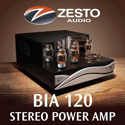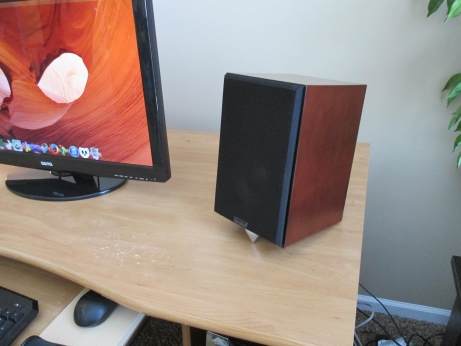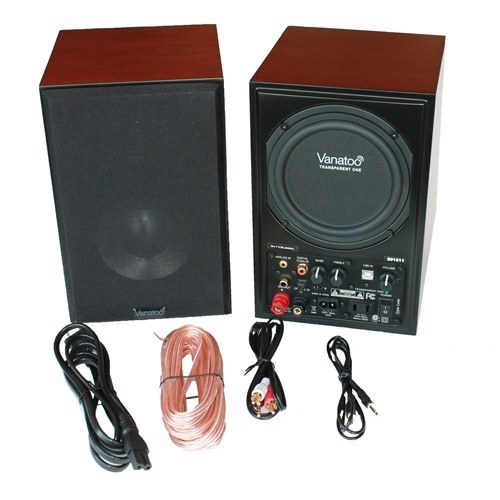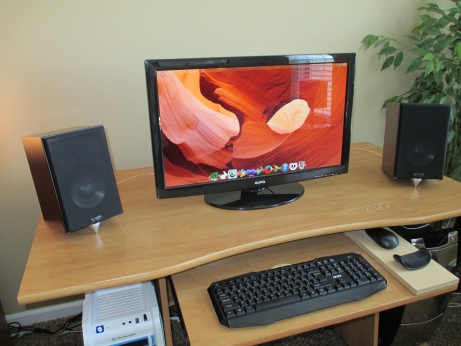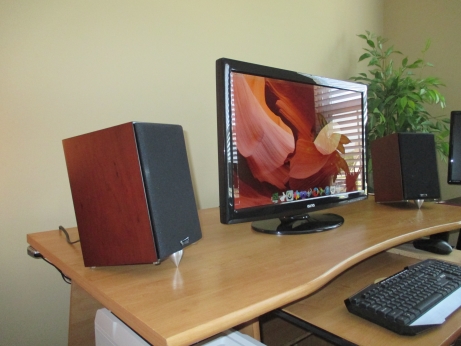|
|
You are reading the older HTML site
Positive Feedback ISSUE 75
vanatoo Transparent One Active Loudspeakers as reviewed by John Acton
Who says you can't teach an old dog new tricks? Even a dyed-in-the-wool two-channel devotee like myself has to acknowledge that the manner in which people listen to music has transformed over the past few years. The decline in physical media, coupled with a corresponding increase in downloads and streaming, has freed music lovers from the confines of stationary listening. Audiophiles, too, have branched out into alternative listening habits, employing high-end portable DACs to play high-res downloads via high-quality headphones. And with so many of us spending more and more time in front of our computers, laptops and tablets, audio manufacturers have started to provide reference-level desktop listening solutions. One such company is Vanatoo, located just outside of Seattle in Washington state. Vanatoo founders Gary Gesellchen and Rick Kernen have a combined 60 years of experience as technical engineers and a lifelong passion for audio reproduction. Together, Gesellchen and Kernen focused their talents on creating the Transparent One, an affordably-priced active loudspeaker system with audiophile aspirations.
Vanatoo packs a lot of technology into the diminutive Transparent One. First and foremost, the Transparent One is a two-way loudspeaker, whose driver complement comprises a 1" soft-dome tweeter and 5 1/4" aluminum woofer. Unusually, especially in its price range, the woofer is loaded by a rear-mounted 5 1/4" passive radiator rather than the ubiquitous reflex port. The Transparent One incorporates an onboard Class D amplifier that delivers 60 watts to each of the two speakers, and 24-bit digital signal processing (DSP) is utilized to optimize frequency response. Additionally, the aluminum woofer employs patented XBL technology, and while no detail is provided by Vanatoo regarding its functionality, it is said to lower the system's cutoff frequency and reduce distortion.
Including active amplification and DSP not only maximizes the amplifier-to-speaker interface, but also allows for considerable user connectivity and configuration options. The Transparent One's electronics operate solely in the digital domain. Digital inputs include toslink, coaxial and USB, and for those users with analog outputs, a 1/8" input jack is provided; a built-in analog-to-digital converter (ADC) converts these signals to digital for subsequent processing and amplification. In addition to volume, there are controls for bass and treble adjustment. A subwoofer output is provided, and if utilized, the Transparent One's circuit automatically routes all frequencies below 150Hz to the subwoofer. Specifications for the Transparent One speaker include a frequency response of 48Hz – 20KHz +/- 3dB and DSP resolution of 48k at 24-bits. The coaxial, toslink and USB digital inputs provide a maximum sample rate of 96k at 24-bits. Protection circuitry is included and monitors for thermal overload, short circuit and amplifier over-current conditions. The system will automatically enter into a low-power sleep mode after 10 minutes without an input signal present. The Transparent One comes with a three-year warranty. The physical dimensions of the Transparent One are 10" high by 6.5" wide by 7.5" deep. The active speaker with the controls on the back panel adds an additional inch or so the depth, translating to 8.5" deep. The passive speaker weighs 11 pounds, and the active speaker weighs 12 pounds. Each speaker is finished in real-wood veneer, and the user can choose between black or cherry. Additional-cost options include Bluetooth or Air Play connectivity. The Vanatoo website provides a matrix outlining all devices supported by the Transparent One, and I won't go into detail listing them here, but suffice to say that nearly every user's connectivity needs are covered. The Transparent Ones arrived in a single double-boxed carton and were in pristine shape. Inside the box were the two speakers, grille cloths, a quick-start reference guide, a more detailed user manual, an AC power cord, patch cords for connecting to source components with either 3.5mm or RCA-jack terminations and a single run of speaker cables for connecting the active speaker to its passive sibling. My review samples came finished in natural cherry and were simply exquisite. Build quality was likewise very substantial and exceeded all expectations for this price range.
Set up of the Vanatoo speakers couldn't be easier. The quick-start reference guide had me up and running within minutes. I placed the Transparent Ones on either side of my desk, flanking the computer monitor, and I toed them in so that their axes crossed about three feet behind my head. I optimized the vertical listening axis by placing a tip-toe under the front of each speaker. I connected the active Vanatoo to my computer's sound card via the supplied 3.5mm—3.5mm cord, connected the active speaker to the passive speaker via the supplied cable and plugged in the AC cord. I typically listened with the tone controls at or near their flat positions and with the grille cloths in place. Listening to Transparent Ones, I was struck by their tonal accuracy and lack of coloration. There was nothing hyped or exaggerated about the sonic presentation, just a natural ease that encouraged extended listening. I was impressed with the amount of bass that Vanatoo was able to coax out of the Transparent Ones' diminutive cabinets. Kick-drum and other mid-bass instruments were reproduced with richness and authority. Listening to "Dogs of War" from Pink Floyd's Momentary Lapse of Reason Columbia CK68518), I heard an enveloping fullness that helped anchor the song's underlying menace. Electronic music, such as "Pistolero" from Juno Reactor's Shango (Metropolitan Records MET 185), was also well served by the Transparent Ones' bass extension. While the little Vanatoo speakers can't rewrite the laws of physics, there was enough mid-bass punch to convey the track's propulsive rhythmic drive. And, the Transparent didn't lose its composure as the volume scaled up, showing little signs of compression until well past my ears' pain threshold. Moving up the spectrum, the midrange was similarly warm and full-bodied, and while fundamentally accurate, was a bit recessed. The slight reticence, despite taking away some of the bite and immediacy of Miles Davis' trumpet on "So What" from his seminal Kind of Blue release (Columbia CK64935), was a boon to long listening sessions, where upfront tonality can quickly become fatiguing. Surprisingly, vocal intelligibility on spoken movie dialog was not at all compromised, remaining pellucid even at low listening levels. The Vanatoo Transparent One's treble was extended, refined and articulate, and evinced no harshness, grain or other distortions that might serve to distract from the musical message. The transition between the woofer and tweeter was seamless, and overall coherency was excellent, even at extremely close listening distances. Soundstaging was a strong suit of the Transparent One. With toe-in optimized, image focus was outstanding, and there was considerable depth to the soundstage. What really stood out was the layering of images in the depth plane. Performers were not bunched up together, but were clearly demarcated and playing in their own spaces. Listening to "Dancing on a Highwire" from The Alan Parsons Project's Ammonia Avenue release (Arista ARCD 8204), Colin Bluntstone's vocals floated between and just behind the Vanatoo speakers, with the band spread out further back. Soundstage width was good, not exceptional, only rarely expanding outward beyond the speaker cabinets themselves. What about shortcomings? Well, given their size and lack of subwoofer, truly low bass is missing in action, but that is not so much a weakness as an acknowledgment of the laws of physics. The Transparent Ones' neutrality and lack of embellishment, while one of their strengths, could also be a detriment when playing MP3 or other lossy formats; the Vanatoo speakers did nothing to obfuscate the spatial flattening and truncated air associated with such compromised sources. From a comparison perspective, I pitted the Vanatoo Transparent Ones against Acoustic Energy's Aego M system, on loan from my brother. The Aego M comprises two small satellites and a separate woofer module that also contains the amplifier and electronics. There were marked sonic differences between the Transparent Ones and the Aego M system. The Aego M was more forward sounding in the midrange and lower treble, imbuing all material played over it with a sense of heightened detail and excitement. The Transparent Ones countered with a more neutral, laid-back balance that encouraged extended listening. The Aego M possessed greater bass extension, but at the expense of the Transparent One's superior cohesion across the musical spectrum. The Aego M system threw a slightly wider soundstage, but the Transparent Ones were far superior at portraying depth, the layering of images in the depth plane and overall image specificity. Towards the end of the review period, I connected the Transparent Ones to my computer via its digital output, thereby bypassing the multiple stages of digital-to-analog and corresponding analog-to-digital conversion. The result was greater transparency, immediacy and an overall cleaner presentation. The improvements were not earth-shattering by any means, but were clearly discernible. Considering their relatively modest cost, the Vanatoo Transparent One speakers represent tremendous value. Build construction is exemplary and the flexibility in providing a myriad of connectivity options allows the speakers to easily integrate into nearly any music lover's system. More importantly, the Transparent Ones provide audiophile sound quality in a convenient, attractive, and self-contained package. The overall performance envelope possesses true high-end aspirations and exceeds that of any separate amplifier, DAC, and speaker combination that I'm aware of anywhere near its price. John Acton
Transparent One (active speaker system)
Vanatoo |






